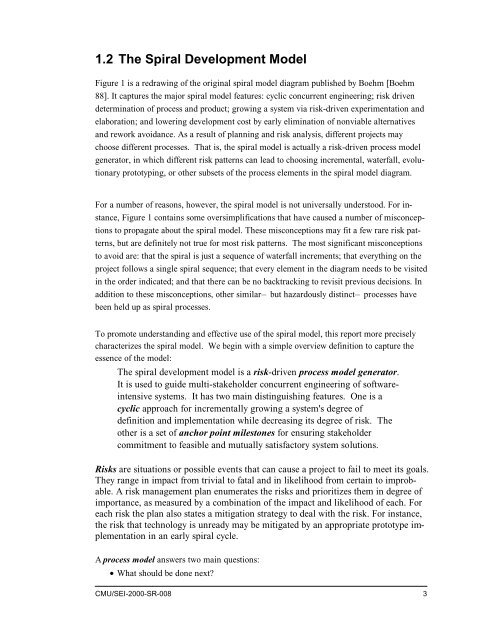00sr008
00sr008
00sr008
You also want an ePaper? Increase the reach of your titles
YUMPU automatically turns print PDFs into web optimized ePapers that Google loves.
1.2 The Spiral Development Model<br />
Figure 1 is a redrawing of the original spiral model diagram published by Boehm [Boehm<br />
88]. It captures the major spiral model features: cyclic concurrent engineering; risk driven<br />
determination of process and product; growing a system via risk-driven experimentation and<br />
elaboration; and lowering development cost by early elimination of nonviable alternatives<br />
and rework avoidance. As a result of planning and risk analysis, different projects may<br />
choose different processes. That is, the spiral model is actually a risk-driven process model<br />
generator, in which different risk patterns can lead to choosing incremental, waterfall, evolutionary<br />
prototyping, or other subsets of the process elements in the spiral model diagram.<br />
For a number of reasons, however, the spiral model is not universally understood. For instance,<br />
Figure 1 contains some oversimplifications that have caused a number of misconceptions<br />
to propagate about the spiral model. These misconceptions may fit a few rare risk patterns,<br />
but are definitely not true for most risk patterns. The most significant misconceptions<br />
to avoid are: that the spiral is just a sequence of waterfall increments; that everything on the<br />
project follows a single spiral sequence; that every element in the diagram needs to be visited<br />
in the order indicated; and that there can be no backtracking to revisit previous decisions. In<br />
addition to these misconceptions, other similar— but hazardously distinct— processes have<br />
been held up as spiral processes.<br />
To promote understanding and effective use of the spiral model, this report more precisely<br />
characterizes the spiral model. We begin with a simple overview definition to capture the<br />
essence of the model:<br />
The spiral development model is a risk-driven process model generator.<br />
It is used to guide multi-stakeholder concurrent engineering of softwareintensive<br />
systems. It has two main distinguishing features. One is a<br />
cyclic approach for incrementally growing a system's degree of<br />
definition and implementation while decreasing its degree of risk. The<br />
other is a set of anchor point milestones for ensuring stakeholder<br />
commitment to feasible and mutually satisfactory system solutions.<br />
Risks are situations or possible events that can cause a project to fail to meet its goals.<br />
They range in impact from trivial to fatal and in likelihood from certain to improbable.<br />
A risk management plan enumerates the risks and prioritizes them in degree of<br />
importance, as measured by a combination of the impact and likelihood of each. For<br />
each risk the plan also states a mitigation strategy to deal with the risk. For instance,<br />
the risk that technology is unready may be mitigated by an appropriate prototype implementation<br />
in an early spiral cycle.<br />
A process model answers two main questions:<br />
•What should be done next?<br />
CMU/SEI-2000-SR-008 3














